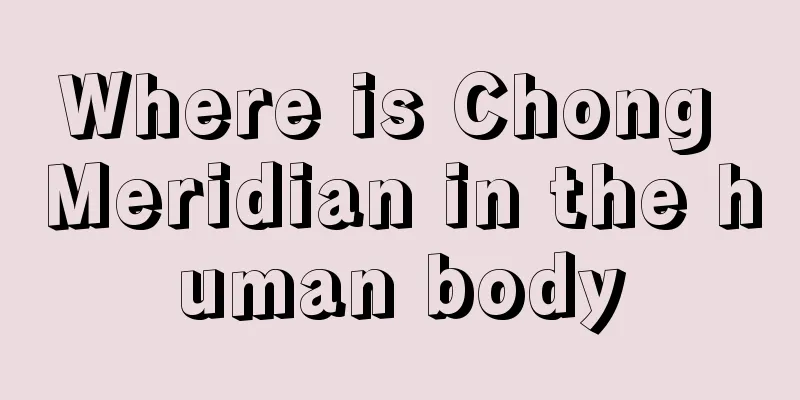Where is Chong Meridian in the human body

|
Everyone knows the profoundness of traditional Chinese medicine, especially the acupoint massage of the body, which is very effective in maintaining the health of various organs. We often hear about Chong Mai in traditional Chinese medicine, but where is Chong Mai in the human body? The so-called Chong Meridian is actually a whole line of acupuncture points, from the head to the soles of the feet. Of course, each part is divided into different acupoints. You can massage them after understanding each acupoint to achieve the effect of strengthening your body. The word "Chong" in Chong Mai means important and vital road. The Chong Meridian runs from the head to the feet, running through the entire body. It is the key point that controls the Qi and blood of all the meridians. The Chong Meridian is the sea of the twelve meridians of the five internal organs and six bowels, and all the five internal organs are nourished by its qi and blood. Its ascending branch originates from the upper throat and the posterior nasal passage, and infuses essence and energy into the yang meridians. The downward branch is injected into the large collateral of the Kidney Meridian of Foot Shaoyin, and it branches out from the Qichong part, goes down along the inner side of the thigh, enters the pit, goes down along the inner side of the tibia deep in the calf, and divides into two branches at the upper edge of the calcaneus behind the medial malleolus, running parallel to the Shaoyin Meridian of Foot, infusing the essence and energy into the Three Yin Meridians of Foot; the forward branch branches out from the upper edge of the calcaneus deep behind the medial malleolus, and enters between the big toes along the dorsum of the foot. The Chong Meridian is the sea of the twelve meridians. It originates from under the kidney together with the Foot Shaoyin Collateral, comes out from the Qi Chong part of the Foot Yangming Meridian, goes along the inner side of the thigh, goes down in the middle, then goes down along the inner side of the tibia, and goes down with the Foot Shaoyin Meridian behind the medial malleolus and enters the sole of the foot. Another branch meridian enters obliquely into the medial ankle, exits and enters the place where the tibia and tarsal bone are connected, enters between the big toes through the dorsum of the foot, and enters into the various collateral vessels, playing a role in warming and nourishing the tibia and foot. The Chong Meridian originates from the Qichong point, along with the Foot Shaoyin Kidney Meridian, ascends along both sides of the navel, and disperses to the middle of the chest. Physiological functions (1) Regulating Qi and blood in the twelve meridians: The Chong Meridian runs from the head to the feet, and runs through the entire body. It is the key point that controls the Qi and blood of all the meridians. When the meridians and internal organs have excess Qi and blood, the Chong Mai can contain and store them; when the meridians and internal organs are insufficiently Qi and blood, the Chong Mai can infuse and replenish them to maintain the normal physiological activities of various tissues and organs in the human body. Therefore, it is called the "Sea of the Twelve Meridians", "Sea of the Five Internal Organs" and "Sea of Blood". (2) Main reproductive function: The Chong Meridian originates in the uterus, also known as the "blood chamber" or "blood sea". The Chong Meridian has the function of regulating menstruation. The Chong Meridian is closely related to reproductive function. When a woman's Taichong Meridian is strong, her menstruation will come on time, so she can have children. "When the Taichong Meridian is weak, the heavenly essence is exhausted and the earthly essence is blocked." The "Taichong Meridian" mentioned here refers to the Chong Meridian. In addition, if a man's Chong meridian is not fully replenished congenitally or is injured postnatally, it may lead to a decline in reproductive function. (3) Regulating the rise and fall of Qi: The Chong Meridian joins the Foot Shaoyin Meridian during its circulation, is affiliated with the Yangming Meridian, and is connected to the Jueyin Meridian and the Taiyang Meridian. The Chong Meridian has the function of regulating the rise and fall of Qi in certain organs (mainly the liver, kidneys and stomach). |
<<: What types of kidney disease are there
>>: Watch out for 5 diseases when drooling while sleeping
Recommend
Do you need to peel the eggplant when frying
Eggplant is a vegetable that we eat frequently in...
What can I use to wash off the ink?
It will be very bad if there are children in the ...
Understanding radiotherapy for nasopharyngeal carcinoma
For NPC patients, since the nasopharynx is locate...
Will brain cancer cause inability to walk?
Can brain cancer cause an inability to walk? 1. I...
Can chestnuts be steamed
The main content of chestnuts is starch, so even ...
Codonopsis pilosula, Radix Ophiopogonis and lean meat soup
The three medicinal herbs, Codonopsis pilosula, O...
Shrimp balls and fish balls are equivalent to contraceptive pills
The statement that shrimp balls and fish balls ar...
Common complications of colon cancer surgery and their treatment
With the remarkable progress in modern anesthesia...
Is air cupping useful
Air cupping is beneficial to the body. It can not...
What is the jingle about the function of meridians
As we all know, meridians are of vital importance...
What is the normal temperature for an adult?
The normal human body temperature should be betwe...
What are the symptoms of infection with Streptococcus agalactiae
Streptococcus agalactiae is a pathogen that cause...
How much urine does a normal person produce per day?
A normal person has a certain amount of urine eve...
How long can a person with laryngeal cancer metastasize to the lymph nodes?
How long can a person live with laryngeal cancer ...
The role and function of calcium, magnesium and zinc
We all know that human growth and development req...









